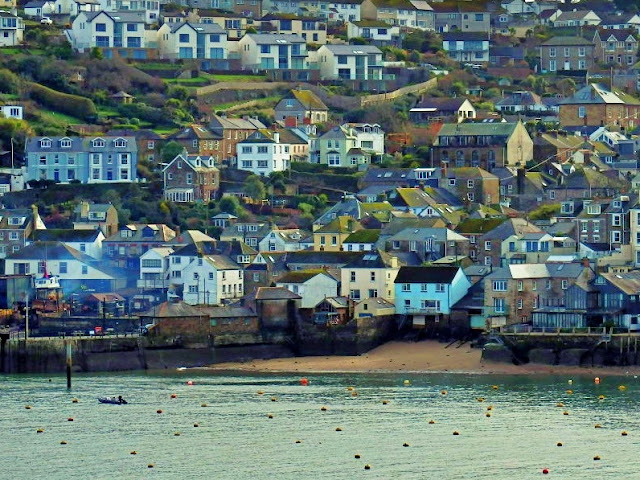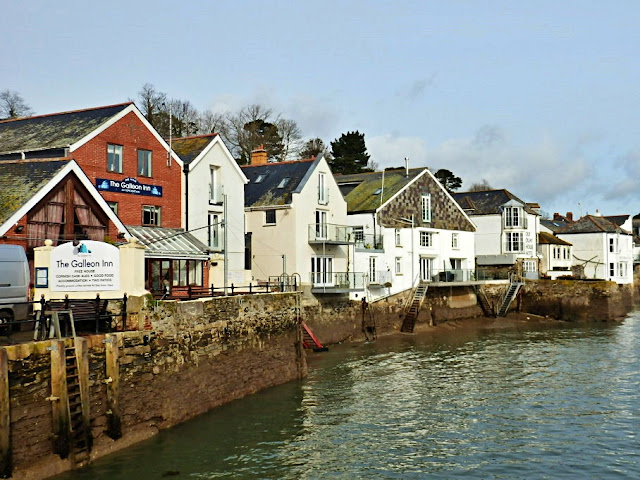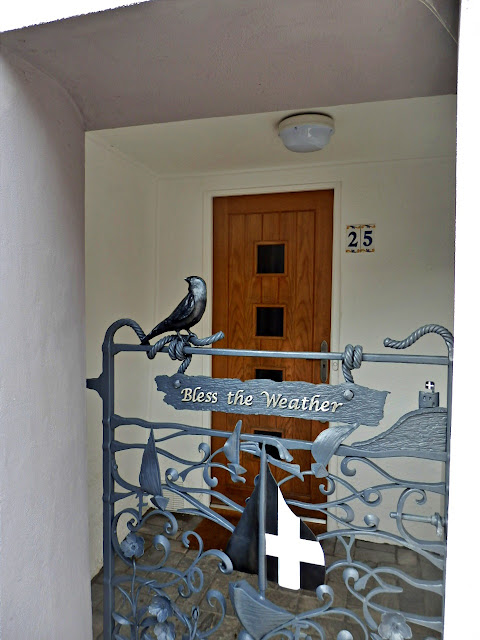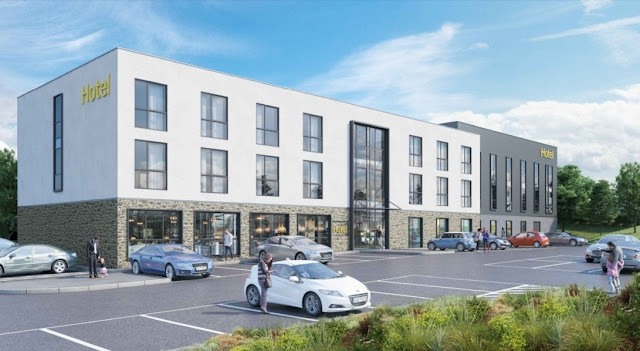Monday 24 February 2020
14 Photos of DuPorth Beach, Cornwall
Following on from previous posts mentioning Duporth Beach today we are actually on the beach - and what's more the sun is shining. Pretty good for February.
Duporth means two coves in the Cornish language. On some older maps it is shown as Du Porth.
Access to the beach is only via the South West Coast Path. There are steps down from the path. The beach is backed by high cliffs.
The photos above and below show water running down the cliffs. You may be able to see a light coloured rainbow as the sun shines on the water in the photo below.
It has to be mentioned that the cliffs are subject to rock falls - see the sign below.
Lots of rocks on the beach.
The cliffs are higher at the far end of the beach.
More rocks.
Interesting how the rocks vary - well, at least it is for me.
Looking up at the far end of the beach a tree balances precariously on the edge.
Rocks of all sorts reaching the water.
Looking back along the beach
For most of the time we were the only two people on the beach, but two men and a woman arrived walking with their dogs.
There are a few houses on the top of the cliffs. The coastal path passes in front of the houses along the cliff tops.
Back to the steps leading down from the coastal path.
Note that there aren't any facilities, toilets etc. on the beach - and there isn't a car park. This means the beach doesn't get overcrowded.
See also: Walking From Porthpean Beach to Duporth and Charlestown, Cornwall - Part 1
Friday 21 February 2020
On Tour: Visiting Glastonbury Abbey, Glastonbury Tor and King Arthur
I know that this blog is titled Mike's Cornwall but at times I do travel further than my home county. So I thought I would occasionally write posts on interesting places I visit. Today that is Glastonbury, I guess this is about 130 miles from Cornwall. So not too far from home.
I find Glastonbury a fascinating place as it has links to the legendry King Arthur - as does Cornwall.
The first two photos show what is left of Glastonbury Abbey. It's still an interesting place to visit and the grounds of the Abbey are very attractive - and, what's more, there is a connection to King Arthur. He may have once been buried here.
There is a sign, as below, which reads: Site of the ancient graveyard where in 1191 the monks dug to find the tombs of Arthur and Guinevere.
There is yet another sign stating: Site of King Arthur's Tomb. In the year 1191 the bodies of King Arthur and his Queen were said to have been found on the south side of the Lady Chapel.
On 19th of April 1278 their remains were removed in the presence of King Edward I and Queen Eleanor to a black marble tomb on this site. This tomb survived until the dissolution of the abbey in 1539.
So there we have it King Arthur was buried here and, as we know, he was supposedly born in Tintagel Castle, Cornwall - well so the story goes.
Judging by the remains of the Abbey it would have once been quite a wonderfully ornate building.
What does remain intact is The Abbot's Kitchen said to be one of the best preserved medieval kitchens in Europe.
The kitchen was built in the 1300s to provide meals for the abbot and his guests. As head of the richest monastery in England, after Westminster, the abbot lived and dined in great splendour.
The monks had their own kitchen and dining room. Their diet though was plain and the eating of meat was restricted. The abbots food was far more elaborate.
I came across the very old picture below which showed the Abbey and grounds as it was in the 1300s.
On the picture 1 is the Abbey, 2 is the Abbots Kitchen and 3 is Glastonbury Tor.
Below is Glastonbury Tor close up. It's a bit of a climb to reach but not too difficult. There are some lovely views from the top. Weather permitting it's possible to see three counties: Somerset, Dorset and Wiltshire.
The word Tor has a Celtic origin meaning hill. The conical nature of Glastonbury Tor is natural. It is made up of horizontal bands of clays and limestone with a cap of hard sandstone.
At the top of the Tor is St. Michael's Tower, part of a church which was destroyed by an earthquake in 1275.
The last abbot of Glastonbury Abbey was Richard Whiting, sometimes shown as Whyting. He was hanged, drawn and quartered as a traitor on Glastonbury Tor in 1539.
So there we go, many interesting places to visit besides Cornwall, but I'm always happy to return home.
Tuesday 18 February 2020
A Flavour Of the Old Town of Fowey, Cornwall With 24 Photos
There are pleasant views from the Esplanade, as it's quite high and looks across the Fowey River.
Some of the homes on the edge have a distinct style. Below is The Crab Pot.
On the opposite side of the River Fowey is the lovely village of Polruan.
The house below, one of a terrace, has views of the river - as can be seen by looking through the window!
At the end of the Esplanade we turn right and head into Fowey town. A little damp underfoot because of a fine drizzle!
We soon reach the quayside. Looks so different in the sunshine months when the trees are full of leaves - and there are people strolling about.
Looking along the river from the quayside.
From the quay we walk into Fowey town with the parish church standing high above the shops.
There is an interesting mix of shops.
The Well House Tea Rooms below was once a merchant's house and is said to date back to 1430. It also offers Bed and Breakfast.
Moving on to the Quay Bakery.
Nearly opposite is the Fowey Harbour Office and steps down to the river. There is a sign on the wall stating that: Queen Victoria and Prince Albert landed on this quay on September 8th, 1846.
There is a display on the office wall.
The road wiggles a bit and have to be aware that cars also use the road.
The road gets quite narrow.
There's The Old Police House at number 44.
The small house below has an unusual gate with a Cornish chough bird and the Cornish flag.
Next is somewhere to sit alongside Isla, the Rook with a Book.
Isla celebrates the author Daphne Du Maurier's legacy and her love of Fowey, where she lived.
One of her books includes 'The Birds' which was adapted for Alfred Hitchcock's classic film of the same name.
Isla was unveiled by Daphne's son and is on loan to the Town of Fowey,
If we look across the river we can see the blue shuttered home, to the right of the photo, where Daphne Du Maurier once lived. She was living here when her first book, The Loving Spirit, was published.
The village seen is Bodinnick.
Walking a little further we reach the Fowey to Bodinnick car ferry - also for cyclists and foot passengers. A crossing of some sort is thought to have been here since the 13th century.
Further still along the Fowey River is where large boats are filled with china clay for transportation.
We traced our steps from here. Another attractive cottage.
Once back on the Esplanade, where we started walking, it's all uphill.
In the distance, in the middle of the following photo, is St.Catherine's Castle high on the cliffs. I visited this a while back. See my post:
St. Catherine's Castle, near Ready Money Cove, Fowey, Cornwall
Saturday 15 February 2020
Large New Development at Higher Trewhiddle, Cornwall Is On It's Way
This time last year I wrote a post titled The Green, Green Grass of St.Mewan: But For How Long?
On the post I published the following sign of a promised new development.
The full details of the 'urban expansion' have now been revealed. So the green fields will disappear. Already a roundabout is being built on the A390 - this is the main St.Austell to Truro road.
It seems there will be some 460 new homes built. 115 of these will be defined as 'affordable'. It would be nice to think that these will go to young, local people. Time will tell.
As well as the homes there will be an hotel with 60 bedrooms, a released image shown below.
Oh and, of course, a pub and restaurant, looking something like this computer generated image.

It is said that there will also be six large shops / stores, 612 parking spaces, cycle and footpaths and areas for sports and play areas.
Sadly though, more and more green fields are disappearing. It's a difficult problem as people do need homes, especially affordable homes - and the population is increasing.
As to whether the development will have a detrimental effect on the actual town of St. Austell I guess we'll have to wait and see.
The local Member of Parliament, Steve Double, wrote the following in favour of the development:
"I believe that it is time for fresh thinking to solve the issues that St Austell faces.
Let us work to build the town centre back into a place where people congregate, socialise, eat and drink, and visit small specialist shops. Certain towns in the UK have successfully implemented this model.
We also have to recognise that the large retailers now demand bigger retail units with access to large spaces for car parking. St Austell town centre cannot offer this.
Major retailers have made it clear that they want to come to St Austell, but do not consider the town centre is able to provide the facilities they require. We have had recent experience of retailers considering the town and deciding to go elsewhere.
Most people I talk to are of the view that progress will only now be achieved by the development of an out-of-town shopping centre, as the town centre has failed to deliver large retailers for too long.
The future for St Austell is a vibrant town centre focusing on people and activities, supported by out-of-town retail facilities."
Hopefully Mr. Double will be proven correct.
Hopefully Mr. Double will be proven correct.
Subscribe to:
Posts (Atom)
FEATURED POST
A QUICK GLANCE AT FOWEY, CORNWALL.
We had to make a short visit to Fowey so I snapped a few quick photos as we walked. The first two are views on the way from the Fowey car ...






















































